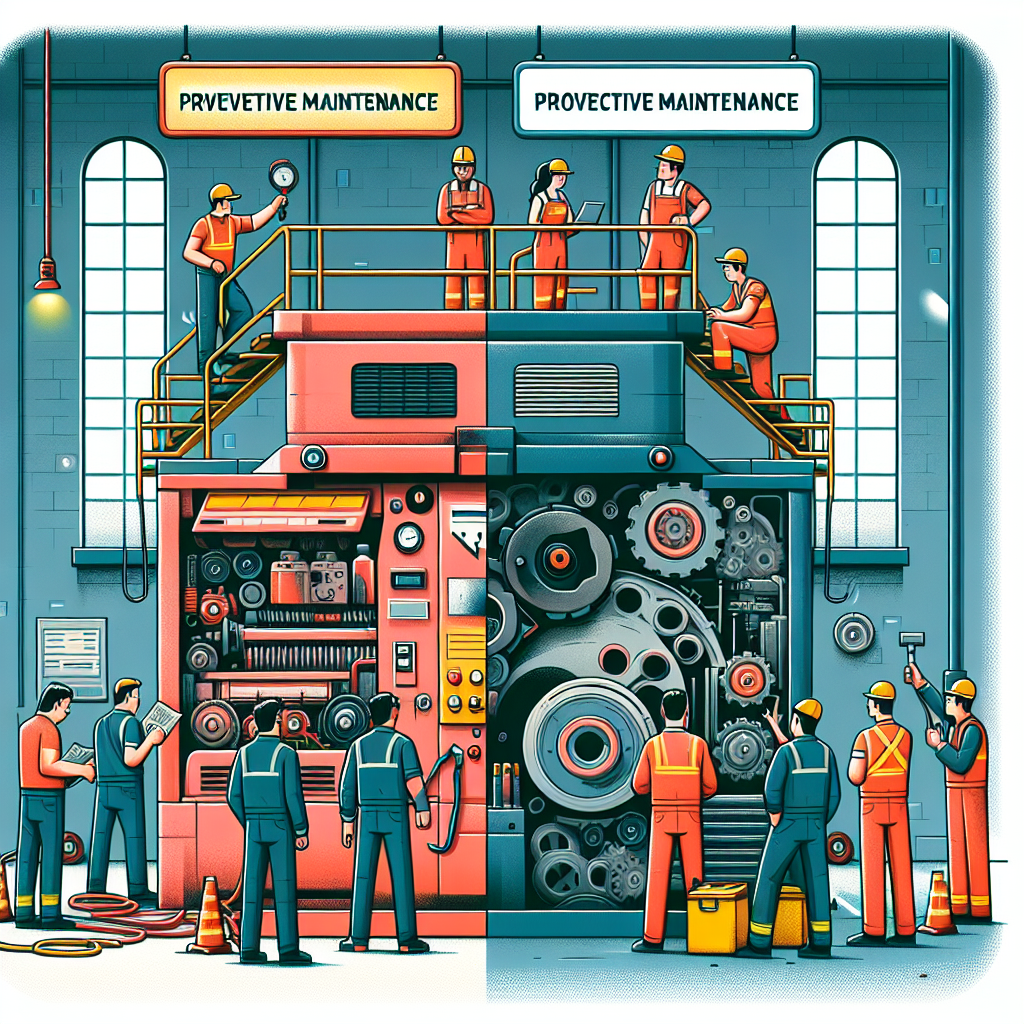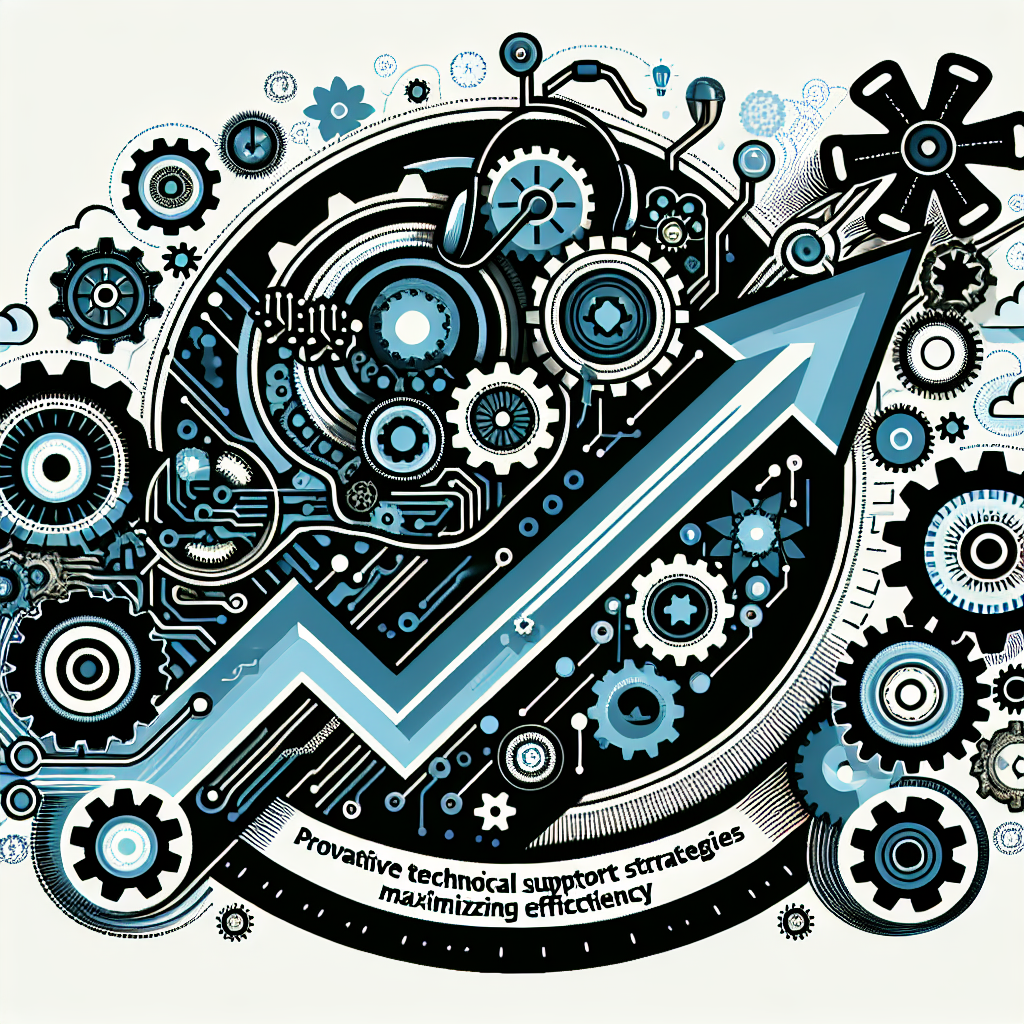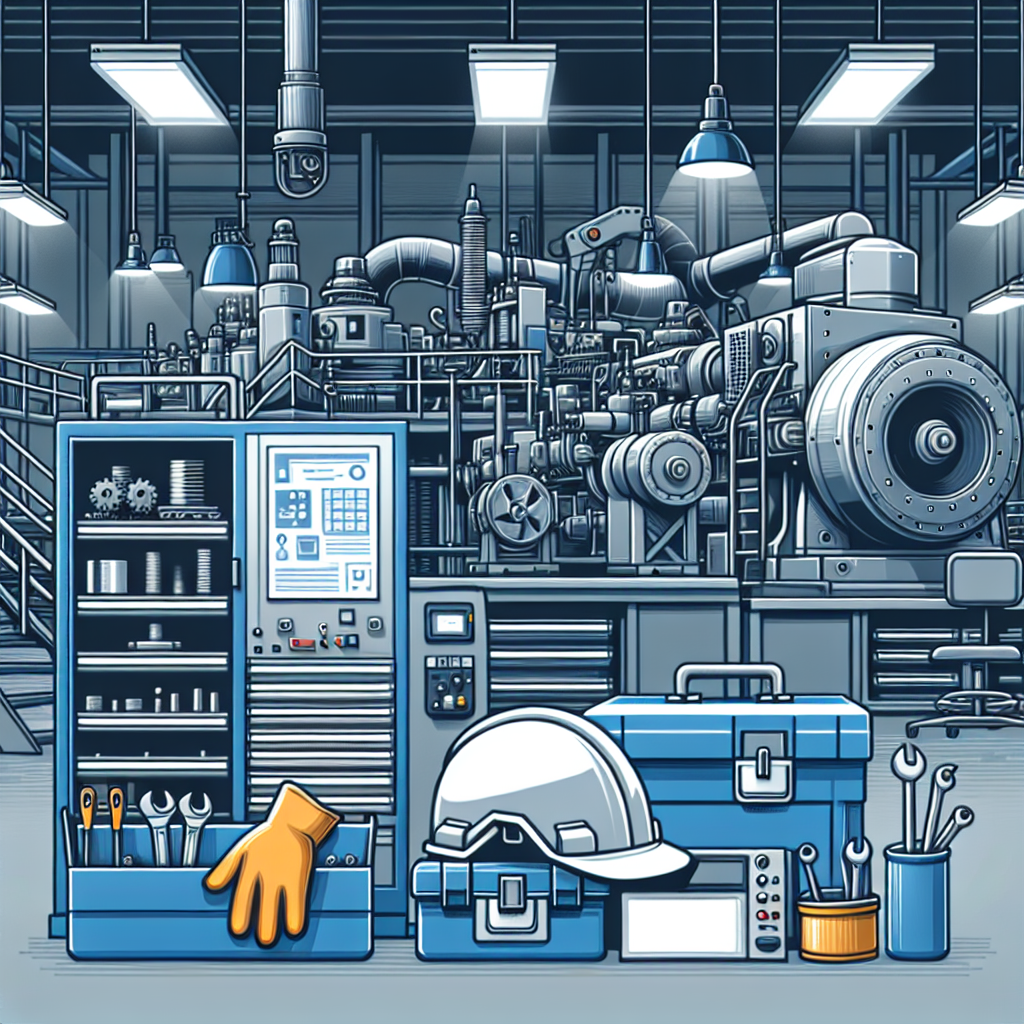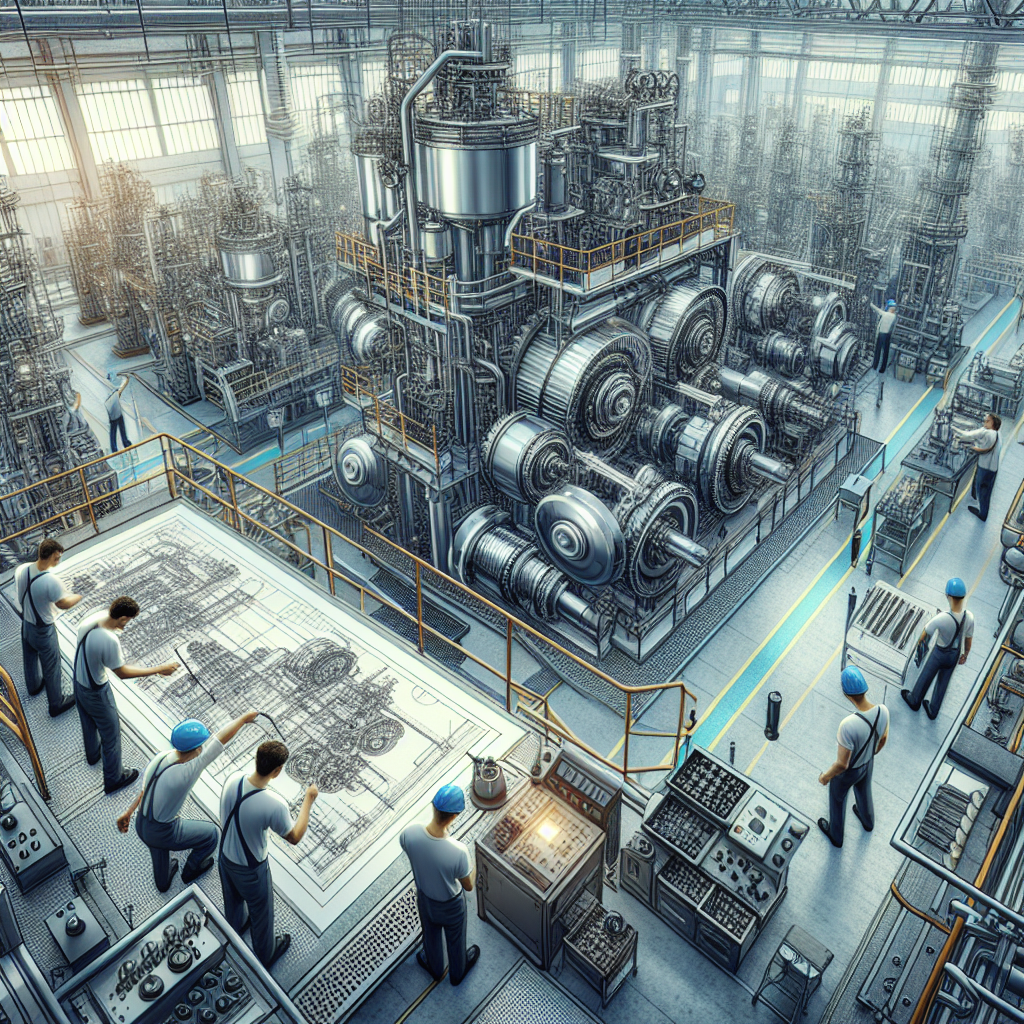Your cart is currently empty!
Tag: Proactive

Proactive Maintenance: A Key Component of Asset Management
Proactive maintenance is a crucial aspect of asset management that can help organizations save time, money, and resources in the long run. By taking a proactive approach to maintenance, businesses can prevent equipment failures, minimize downtime, and extend the lifespan of their assets.Proactive maintenance involves regularly monitoring and inspecting equipment to identify potential issues before they escalate into major problems. This can include conducting routine inspections, performing preventive maintenance tasks, and implementing predictive maintenance techniques such as vibration analysis and oil analysis.
By staying ahead of potential issues, organizations can avoid costly repairs and unplanned downtime, which can have a significant impact on productivity and profitability. Proactive maintenance also enables businesses to better plan and schedule maintenance activities, reducing the likelihood of equipment failures during critical production periods.
In addition to preventing breakdowns, proactive maintenance can also help businesses optimize the performance of their assets. By regularly maintaining equipment and addressing any issues promptly, organizations can ensure that their assets operate at peak efficiency, leading to improved productivity and output.
Furthermore, proactive maintenance can help businesses comply with regulatory requirements and industry standards, reducing the risk of fines or penalties for non-compliance. By staying on top of maintenance activities and documentation, organizations can demonstrate their commitment to best practices and quality standards.
Overall, proactive maintenance is an essential component of asset management that can help organizations maximize the value of their assets, reduce costs, and improve operational efficiency. By investing in proactive maintenance strategies, businesses can ensure the long-term reliability and performance of their assets, ultimately leading to a more sustainable and successful operation.

Preventive vs Proactive Maintenance: Which is Right for Your Business?
Preventive vs Proactive Maintenance: Which is Right for Your Business?Maintenance is an essential aspect of running any business, as it ensures that all equipment and machinery are in good working order and can operate efficiently. When it comes to maintenance strategies, two common approaches are preventive maintenance and proactive maintenance. While both strategies aim to prevent breakdowns and ensure the smooth operation of equipment, they differ in their approach and implementation. So, which maintenance strategy is right for your business?
Preventive maintenance is a strategy that involves performing regular maintenance tasks on equipment at scheduled intervals. These tasks are typically based on manufacturer recommendations or industry best practices. The goal of preventive maintenance is to prevent unexpected breakdowns and extend the lifespan of equipment by addressing potential issues before they become major problems. This approach is often seen as a cost-effective way to maintain equipment and reduce downtime.
On the other hand, proactive maintenance takes a more predictive approach to maintenance. Instead of relying on scheduled intervals, proactive maintenance uses data and analytics to identify potential issues before they occur. By monitoring equipment performance and analyzing trends, businesses can anticipate when maintenance is needed and take action proactively. This approach is often seen as more efficient and can help businesses minimize downtime and maximize equipment efficiency.
So, which maintenance strategy is right for your business? The answer depends on several factors, including the type of equipment you have, your budget, and your business goals. Preventive maintenance may be a good option for businesses with a large fleet of equipment that require regular maintenance. It can help businesses stay on top of maintenance tasks and prevent unexpected breakdowns. However, proactive maintenance may be more suitable for businesses that rely heavily on their equipment and cannot afford any downtime. By taking a proactive approach to maintenance, businesses can identify and address potential issues before they impact operations.
Ultimately, the right maintenance strategy for your business will depend on your specific needs and goals. It may be beneficial to consult with maintenance experts or industry professionals to determine the best approach for your business. Whether you choose preventive maintenance or proactive maintenance, the important thing is to prioritize maintenance and ensure that your equipment is well-maintained to keep your business running smoothly.

Maximizing Efficiency with Proactive Technical Support Strategies
In today’s fast-paced business environment, maximizing efficiency is crucial to staying ahead of the competition. One key component of achieving this goal is proactive technical support strategies. By taking a proactive approach to technical support, businesses can prevent issues before they arise, minimize downtime, and ultimately improve overall productivity.One of the most effective ways to maximize efficiency with proactive technical support strategies is to invest in monitoring and maintenance tools. These tools can help businesses identify potential issues before they become major problems. By regularly monitoring systems and equipment, businesses can address issues early on and prevent costly downtime.
Another important proactive strategy is to regularly update software and hardware. Outdated software and hardware are more prone to security breaches and performance issues, which can disrupt business operations. By staying up-to-date with the latest technology, businesses can ensure that their systems are running smoothly and efficiently.
Additionally, businesses should invest in training for their IT staff to ensure they have the skills and knowledge necessary to proactively address technical issues. By providing ongoing training and professional development opportunities, businesses can empower their IT teams to effectively manage and prevent technical issues.
Furthermore, implementing a proactive maintenance schedule can help businesses avoid unexpected downtime. Regularly scheduled maintenance can help identify and address potential issues before they impact operations. By staying on top of maintenance tasks, businesses can keep their systems running smoothly and efficiently.
Finally, businesses should consider partnering with a managed IT services provider to help maximize efficiency with proactive technical support strategies. Managed IT services providers can offer proactive monitoring, maintenance, and support services to help businesses stay ahead of technical issues. By outsourcing technical support to a trusted provider, businesses can focus on their core operations while ensuring that their systems are running smoothly.
In conclusion, maximizing efficiency with proactive technical support strategies is essential for businesses looking to stay competitive in today’s fast-paced business environment. By investing in monitoring and maintenance tools, staying up-to-date with technology, providing training for IT staff, implementing proactive maintenance schedules, and partnering with a managed IT services provider, businesses can prevent issues before they arise, minimize downtime, and ultimately improve overall productivity.

How to Implement a Successful Proactive Maintenance Program
Implementing a successful proactive maintenance program is crucial for any organization looking to keep their equipment running smoothly and minimize downtime. By taking a proactive approach to maintenance, companies can prevent costly breakdowns and extend the lifespan of their assets. Here are some tips on how to implement a successful proactive maintenance program.1. Establish a maintenance schedule: One of the first steps in implementing a proactive maintenance program is to establish a regular maintenance schedule. This schedule should outline when different types of maintenance tasks need to be performed, such as routine inspections, lubrication, and equipment cleaning. By following a schedule, maintenance tasks are less likely to be overlooked or forgotten, leading to better equipment reliability.
2. Invest in technology: Technology can play a crucial role in a proactive maintenance program. By utilizing tools such as predictive maintenance software, sensors, and monitoring equipment, companies can gather real-time data on the condition of their equipment and identify potential issues before they escalate. This can help prevent unexpected breakdowns and reduce the need for costly repairs.
3. Train your maintenance team: A successful proactive maintenance program relies on a skilled and knowledgeable maintenance team. Make sure to provide your team with the training and resources they need to effectively carry out maintenance tasks. This may include training on equipment operation, maintenance procedures, and how to use maintenance software and tools.
4. Conduct regular inspections: Regular inspections are essential for identifying potential issues before they become serious problems. Inspections should be conducted on a scheduled basis and include checking for signs of wear and tear, leaks, and other issues that could impact equipment performance. By catching issues early, companies can address them before they lead to downtime.
5. Implement a preventive maintenance program: In addition to regular inspections, companies should also implement a preventive maintenance program. This program involves performing maintenance tasks such as equipment calibration, filter replacements, and parts lubrication on a regular basis to prevent issues from occurring. By staying ahead of maintenance tasks, companies can extend the lifespan of their equipment and reduce the risk of unexpected breakdowns.
In conclusion, implementing a successful proactive maintenance program is essential for organizations looking to improve equipment reliability and minimize downtime. By establishing a maintenance schedule, investing in technology, training your maintenance team, conducting regular inspections, and implementing a preventive maintenance program, companies can keep their equipment running smoothly and avoid costly repairs. By taking a proactive approach to maintenance, companies can save time and money in the long run.

Maximizing Efficiency with Proactive Network Management
In today’s fast-paced business environment, it is essential for organizations to maximize efficiency in order to stay competitive and meet the demands of customers. One way to achieve this is through proactive network management, which involves taking a proactive approach to managing and optimizing a company’s network infrastructure.Proactive network management involves monitoring and analyzing network performance on an ongoing basis, rather than waiting for issues to arise before taking action. By regularly monitoring the network, IT teams can identify potential problems before they impact business operations and take preventive measures to address them.
One of the key benefits of proactive network management is improved network reliability and uptime. By identifying and addressing potential issues before they cause downtime, organizations can ensure that their network remains up and running, allowing employees to access critical applications and data whenever they need to.
Proactive network management also helps organizations optimize their network performance. By monitoring key performance indicators such as bandwidth usage, latency, and packet loss, IT teams can identify areas for improvement and make adjustments to ensure that the network is operating at peak efficiency.
Another benefit of proactive network management is enhanced security. By continuously monitoring the network for potential security threats and vulnerabilities, IT teams can quickly identify and remediate any issues before they are exploited by cybercriminals. This proactive approach to security helps organizations safeguard their sensitive data and protect against costly data breaches.
In addition to improving reliability, performance, and security, proactive network management can also help organizations reduce costs. By identifying and addressing network inefficiencies, IT teams can optimize network resources and eliminate unnecessary expenses, such as over-provisioned hardware or underutilized bandwidth.
Overall, proactive network management is a critical component of a successful IT strategy. By taking a proactive approach to managing their network infrastructure, organizations can maximize efficiency, improve reliability, enhance security, and reduce costs. Investing in proactive network management tools and practices can help organizations stay ahead of the curve and ensure that their network infrastructure is ready to support their business goals.

Creating a Culture of Proactive Maintenance in Your Facility
Maintenance is a critical aspect of facility management that can greatly impact the efficiency, safety, and overall performance of a building. While reactive maintenance is often necessary to address immediate issues, proactive maintenance is essential for preventing costly repairs, minimizing downtime, and extending the lifespan of equipment and systems. Creating a culture of proactive maintenance in your facility can help you stay ahead of potential problems and keep your operations running smoothly.One of the key elements of creating a culture of proactive maintenance is establishing a comprehensive maintenance plan. This plan should outline the regular inspection, testing, and servicing of all equipment and systems in your facility. By scheduling routine maintenance tasks, you can identify potential issues before they escalate into major problems and address them in a timely manner.
Training and empowering your maintenance staff is also crucial in promoting proactive maintenance. Invest in ongoing training programs to ensure that your team is knowledgeable about the latest technologies, best practices, and safety protocols. Encourage your staff to take ownership of their work and empower them to make decisions that will benefit the facility in the long run.
Utilizing technology can also help streamline the maintenance process and improve efficiency. Implementing a computerized maintenance management system (CMMS) can help track maintenance tasks, schedule work orders, and generate reports on equipment performance. By leveraging technology, you can better prioritize maintenance tasks, allocate resources effectively, and improve communication within your maintenance team.
Regular communication and collaboration between departments is essential for promoting a culture of proactive maintenance. Encourage open dialogue between the maintenance team, operations staff, and management to share insights, address concerns, and coordinate efforts to optimize facility performance. By fostering a collaborative environment, you can leverage the expertise of all stakeholders to identify potential maintenance issues and develop effective solutions.
Incentivizing proactive maintenance can also help motivate your staff to prioritize maintenance tasks and take a proactive approach to facility management. Recognize and reward employees who go above and beyond in maintaining equipment, identifying potential issues, and implementing preventive measures. By incentivizing proactive behavior, you can create a culture that values maintenance as a critical component of facility operations.
Ultimately, creating a culture of proactive maintenance requires a commitment to ongoing training, communication, collaboration, and incentivization. By investing in your maintenance team, utilizing technology, and fostering a collaborative environment, you can prevent costly repairs, minimize downtime, and ensure that your facility operates at peak performance. By prioritizing proactive maintenance, you can create a culture that values efficiency, safety, and sustainability in your facility.

The Role of Proactive Maintenance in Minimizing Downtime and Disruptions
In today’s fast-paced business environment, downtime and disruptions can have a significant impact on the bottom line. Whether it’s a manufacturing plant, a retail store, or an office building, any interruption in operations can result in lost productivity, revenue, and customer satisfaction. That’s why proactive maintenance plays a crucial role in minimizing downtime and disruptions.Proactive maintenance is a preventive approach to maintenance that focuses on identifying and addressing potential issues before they escalate into major problems. By regularly inspecting equipment, performing routine maintenance tasks, and monitoring performance metrics, organizations can proactively address issues and prevent unexpected breakdowns.
One of the key benefits of proactive maintenance is its ability to minimize downtime. By fixing issues before they cause a breakdown, organizations can avoid costly disruptions to operations. This not only saves time and money but also helps maintain a positive reputation with customers and stakeholders.
Additionally, proactive maintenance can help improve the overall reliability and performance of equipment. By regularly maintaining and servicing machinery, organizations can extend the lifespan of their assets and ensure that they operate at peak efficiency. This can result in increased productivity, reduced operating costs, and a higher return on investment.
Another important aspect of proactive maintenance is its ability to improve safety and compliance. By following a proactive maintenance schedule, organizations can ensure that equipment meets regulatory standards and is safe for employees to operate. This can help prevent accidents, injuries, and costly fines associated with non-compliance.
In conclusion, proactive maintenance plays a critical role in minimizing downtime and disruptions in today’s business environment. By taking a proactive approach to maintenance, organizations can improve reliability, performance, and safety, while also reducing costs and increasing productivity. Investing in proactive maintenance is a smart decision that can help organizations stay competitive and successful in the long run.

How Proactive Maintenance Can Improve Efficiency and Productivity
Proactive maintenance is a strategy that focuses on preventing equipment failure before it occurs, rather than waiting for a breakdown to happen and then fixing it. This approach can significantly improve efficiency and productivity in a variety of industries, from manufacturing to healthcare.One of the key benefits of proactive maintenance is that it helps to avoid costly downtime. When equipment breaks down unexpectedly, it can take hours or even days to repair, leading to lost production time and revenue. By regularly inspecting and maintaining equipment, issues can be identified and addressed before they cause a breakdown, reducing the risk of unplanned downtime.
Proactive maintenance also helps to extend the lifespan of equipment. Regular maintenance checks can identify wear and tear on components, allowing them to be replaced or repaired before they fail completely. This not only saves money on expensive repairs, but also prolongs the life of the equipment, reducing the need for costly replacements.
In addition to preventing breakdowns and extending equipment lifespan, proactive maintenance can also improve efficiency and productivity in other ways. For example, by keeping equipment in optimal working condition, it can operate more efficiently, using less energy and resources to perform the same tasks. This can lead to cost savings and increased output.
Furthermore, proactive maintenance can help to improve safety in the workplace. Regular inspections can identify potential hazards or safety risks, allowing them to be addressed before they cause an accident or injury. This not only protects employees, but also helps to avoid costly fines and legal issues that can arise from workplace accidents.
Overall, proactive maintenance is a proactive approach that can have a positive impact on efficiency, productivity, and safety in any industry. By investing in regular maintenance checks and inspections, businesses can reduce downtime, extend equipment lifespan, improve efficiency, and enhance workplace safety. This can lead to cost savings, increased output, and a more efficient and productive operation overall.

Proactive vs. Reactive Maintenance: Why Being Proactive is Crucial
Maintenance is an essential aspect of keeping any system running smoothly and efficiently. However, there are two main approaches to maintenance: proactive and reactive. Proactive maintenance involves taking preventative measures to avoid breakdowns and issues before they occur, while reactive maintenance involves fixing issues as they arise.While reactive maintenance may seem like a quick and easy solution to problems, it is often more costly and time-consuming in the long run. When equipment breaks down unexpectedly, it can lead to costly repairs, downtime, and lost productivity. In contrast, proactive maintenance allows for scheduled maintenance and inspections to identify and address potential issues before they become major problems.
Being proactive with maintenance not only saves time and money but also helps to prolong the lifespan of equipment and machinery. By regularly monitoring and maintaining equipment, businesses can avoid costly repairs and replacements, as well as reduce the risk of unexpected downtime.
Proactive maintenance also promotes a safer work environment. By addressing potential safety hazards before they cause harm, businesses can prevent accidents and injuries in the workplace. This not only protects employees but also helps to maintain compliance with health and safety regulations.
Furthermore, being proactive with maintenance can improve overall efficiency and productivity. When equipment is properly maintained and running smoothly, it can operate at peak performance levels, leading to increased productivity and output. This can ultimately result in higher profits and a competitive edge in the market.
In conclusion, being proactive with maintenance is crucial for businesses to ensure the smooth operation of equipment, reduce costs, maintain a safe work environment, and improve overall efficiency and productivity. By investing in proactive maintenance strategies, businesses can protect their assets, employees, and bottom line.

Enhancing Security and Compliance through Proactive IT Infrastructure Management
In today’s fast-paced and constantly evolving digital landscape, businesses are faced with the increasing challenge of ensuring the security and compliance of their IT infrastructure. With cyber threats becoming more sophisticated and regulatory requirements becoming stricter, it is essential for organizations to take a proactive approach to managing their IT infrastructure in order to protect their sensitive data and ensure regulatory compliance.One of the key ways to enhance security and compliance is through proactive IT infrastructure management. This involves continuously monitoring and managing the various components of an organization’s IT infrastructure, such as servers, networks, and applications, to identify and address potential security vulnerabilities and compliance issues before they can be exploited by cyber attackers or result in regulatory violations.
By taking a proactive approach to IT infrastructure management, organizations can stay one step ahead of potential security threats and compliance issues. This can help to prevent data breaches and other cyber attacks, as well as avoid costly fines and penalties for non-compliance with regulations such as GDPR, HIPAA, and PCI DSS.
There are several key strategies that organizations can implement to enhance security and compliance through proactive IT infrastructure management. These include:
1. Regular vulnerability assessments: Conducting regular vulnerability assessments of the IT infrastructure can help to identify potential security weaknesses that could be exploited by cyber attackers. By addressing these vulnerabilities before they can be exploited, organizations can reduce the risk of a data breach or other security incident.
2. Patch management: Keeping software and hardware up to date with the latest security patches is essential for mitigating security risks. Proactive patch management can help to ensure that known vulnerabilities are addressed in a timely manner, reducing the likelihood of a security breach.
3. Network monitoring: Continuous monitoring of network traffic can help to detect and respond to suspicious activity, such as unauthorized access attempts or data exfiltration. By monitoring network traffic in real-time, organizations can quickly identify and mitigate potential security threats.
4. Compliance audits: Regular compliance audits can help to ensure that an organization’s IT infrastructure meets the requirements of relevant regulations and standards. By proactively addressing compliance issues, organizations can avoid costly fines and penalties for non-compliance.
5. Incident response planning: Developing a comprehensive incident response plan can help organizations to respond quickly and effectively to security incidents. By having a plan in place to contain and mitigate the impact of a security breach, organizations can minimize the damage to their reputation and bottom line.
In conclusion, enhancing security and compliance through proactive IT infrastructure management is essential for organizations looking to protect their sensitive data and comply with regulatory requirements. By implementing strategies such as regular vulnerability assessments, patch management, network monitoring, compliance audits, and incident response planning, organizations can stay ahead of potential security threats and compliance issues. By taking a proactive approach to IT infrastructure management, organizations can reduce the risk of data breaches, avoid costly fines and penalties, and protect their reputation and bottom line.
